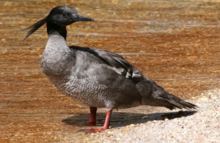Brazilian merganser
This article includes a list of general references, but it lacks sufficient corresponding inline citations. (January 2009) |
| Brazilian merganser | |
|---|---|

| |
| Scientific classification | |
| Domain: | Eukaryota |
| Kingdom: | Animalia |
| Phylum: | Chordata |
| Class: | Aves |
| Order: | Anseriformes |
| Family: | Anatidae |
| Genus: | Mergus |
| Species: | M. octosetaceus
|
| Binomial name | |
| Mergus octosetaceus Vieillot, 1817
| |

| |
The Brazilian merganser (Mergus octosetaceus) is a South American diving duck in the Mergus genus. It is one of the most
Description
This merganser is a dark, slender duck with a shiny dark-green hood with a long crest, which is usually shorter and more worn-looking in females. Upperparts are dark grey while the breast is light grey, getting paler toward the whitish belly, and a white speculum is particularly noticeable in flight.[2]: 81796 It has a long thin jagged black bill with red feet and legs. Although females are smaller with a shorter bill and crest, both sexes are alike in color. The slender ducks range in size from 49 to 56 centimetres (19 to 22 in) as an adult. Young Brazilian mergansers are mainly black with white throat and breast.
The Brazilian mergansers are generally silent birds, but may make barking calls in certain situations. Four calls have been recorded. A harsh krack-krack acts as an
Depending on the availability of suitable nesting and feeding sites, Brazilian merganser pairs occupy permanent
Population
The merganser population is believed to have less than 250 birds. Originally, the duck's geographical distribution comprised central-south Brazil and adjacent regions in
In 2002, the species was also found on the
Habitat
The slender Brazilian mergansers live in low densities in remote and mountainous regions where it inhabits clean rivers and streams with river rapids and riparian vegetation. Brazilian mergansers are very territorial birds defending large stretches of river and the land surrounding the fast-flowing water. They are recognized as a resident species that does not abandon the watercourses where it established its territory. They do not move or want to move once their habitats have disappeared. The birds need large territories and their habitat is fast dwindling.
Threat
The Brazilian mergansers are very sensitive to habitat degradation and loss primarily due to human actions. A major threat to the birds' survival is the issue of
Current traditional
A new threat to the species includes the installation of
Dam-building has also become a major part in the disappearance of these birds. The filling of the Urugua-i reservoir, which took place between 1989 and 1991, had a major impact on Brazilian mergansers in Argentina. The population declined drastically when its fast-flowing rivers were turned into large lakes. After the Urugua-i dam was built, the birds have only been seen on the Uruzu stream, a tributary of the Urugua-i. The dams flood suitable habitat, especially in Brazil and Paraguay, where the Brazilian mergansers build their nests and lay their eggs.
Another threat to the Brazilian merganser is
Other threats include
References
- ^ . Retrieved 12 November 2021.
- ^ 75 FR 81794
- ^ "Brazilian Merganser". Wildfowl & Wetlands Trust. Archived from the original on 7 November 2007. Retrieved 8 June 2009.
- Argentina Guide. "Nature in Iguazu". Enjoy Argentina. November 25, 2008 [1].
- Barbosa, M. O. & Almeida, M. L. (2010). Novas observações e dados reprodutivos do pato-mergulhão Mergus octosetaceus na região do Jalapão, Tocantins, Brasil. Cotinga 32: OL 40–45.
- BirdLife International (2008) Species factsheet: Mergus octosetaceus. Accessed from birdlife.org on 2/12/2008.
- BirdLife International (October, 2006)[2].
- "Brazilian Merganser". Wildfowl and Wetlands Trust. November 10, 2008 [3].
- "Critically Endangered Brazilian Merganser to be radio tagged ". Wildlife Extra. November 10, 2008 [4].
- De Luca, Arthur, Develey Pedro, and Olmos Fabio. Final Report: Waterbirds in Brazil. São Paulo, Brasil: Rua Fernão Dias, 2006.
- del Hoyo, J., Elliott, A. and Sargatal, J. (1992) Handbook of the Birds of the World – Ostrich to Ducks. Vol. 1. Lynx Edicions, Barcelona.
- "Environmental Education for the Conservation of a Critically Endangered Species". Terra Brasilis Institute. December 2, 2008 [5][permanent dead link].
- Fereiro Bruno, Sávio; de Carvalho, Rafael Bessa Alves; Bartmann, Wolf (2006). "Reproductive Rate and Development of Ducklings of Brazilian Merganser at Serra da Canastra National Park, Minas Gereias, Brazil, 2001-2005" TWSG News 15: 25–33 [6][permanent dead link]
- Galindo-Leal, Carlos, and Isben de Gusmao Camara. The Atlantic Forest of South America: Biodiversity Status, Threats, and Outlook. Island Press, 2003.
- Grosset, Arthur. "Brazilian Merganser". Arthur Grosset's Birds. November 10, 2008 [7]
- Wildlife Extra, "Critically Endangered Brazilian Merganser to be radio tagged ". Wildfowl and Wetlands Trust. December 1, 2008 [8].
- William H. Partridge The Auk, Vol. 73, No. 4 (Oct., 1956), pp. 473–488. Published by: University of California Press on behalf of the American Ornithologists' Union Stable [9]

